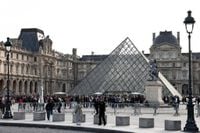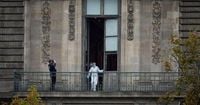Paris is no stranger to drama, but few events in recent years have rattled the city’s nerves quite like the daring theft of the nation’s crown jewels from the Louvre Museum on October 19, 2025. In a caper that has left both officials and the public reeling, a group of thieves managed to snatch eight priceless artifacts from the Apollo Gallery—home to France’s royal and imperial treasures—in a heist that lasted less than eight minutes. Now, just over a week later, French authorities have arrested two suspects, offering a glimmer of hope that justice will be served and the country’s cultural heritage restored.
According to the Paris prosecutor Laure Beccuau, the arrests took place on the evening of October 25. One of the men was apprehended at Paris Charles de Gaulle Airport as he prepared to board a flight to Algeria, while the other was detained as he was getting ready to travel to Mali. Both suspects, men in their thirties from Aubervilliers in the Seine-Saint-Denis department—a densely populated suburb northeast of Paris—are already known to police for previous jewelry store thefts, as reported by Le Parisien and Deseret News.
The theft itself was as audacious as it was meticulously planned. French officials described how the intruders used a basket lift to scale the Louvre’s iconic façade, forced open a window, and then smashed their way into the Apollo Gallery using an angle grinder. Within seven to eight minutes, the thieves had broken into two glass cases and made off with eight irreplaceable pieces of jewelry, collectively valued at between €88 million and $102 million—an amount that is staggering by any measure. Among the stolen treasures were a sapphire diadem, necklace, and single earring linked to 19th-century queens Marie-Amélie and Hortense; an emerald necklace and earrings tied to Empress Marie-Louise, Napoleon Bonaparte’s second wife; a reliquary brooch; Empress Eugénie’s diamond diadem and large corsage-bow brooch; and Eugénie’s emerald-set imperial crown, adorned with more than 1,300 diamonds. The latter was later found outside the museum, damaged but repairable.
For many in France and beyond, the loss of these jewels was more than a financial blow—it was a cultural wound. Some even compared it to the burning of Notre Dame Cathedral in 2019, a moment that left the nation in mourning. The fact that the items are uninsured only heightened the sense of urgency and despair. As The Associated Press reported, if police fail to recover the jewels, France will not be reimbursed for their loss. "It's important for our heritage. A week later, it does feel a bit late, we wonder how this could even happen—but it was important that the guys were caught," Louvre visitor Freddy Jacquemet told TVNZ. Another visitor, Diana Ramirez, added, "I think the main thing now is whether they can recover the jewels. That's what really matters."
The investigation into the heist has been nothing short of exhaustive. Over 100 investigators have been mobilized to track down the perpetrators and recover the stolen artifacts. According to Paris prosecutor Laure Beccuau, a special police unit specializing in armed robberies, serious burglaries, and art thefts led the efforts. Forensic experts analyzed more than 150 samples collected from the scene, including gloves, a walkie-talkie, a vest, and a can of gasoline left behind by the thieves. DNA evidence from these items played a crucial role in identifying the suspects, as confirmed by French police union spokesman Axel Ronde in an interview with Deseret News. "They left gloves, a walkie-talkie, a vest and a can of gasoline. And that allowed my colleagues from the forensic team to find these DNA traces," Ronde explained.
But the investigation didn’t stop at DNA. Officials also focused on fingerprints and a thirty-six-second video clip that captured the thieves making their getaway on the basket lift. The rapid progress in the case has been widely praised, with French Interior Minister Laurent Nunez commending "the investigators who have worked tirelessly, just as I asked them to, and who have always had my full confidence."
The theft has also exposed significant vulnerabilities in the Louvre’s security infrastructure. Although the museum’s alarms functioned as intended and staff followed protocol, it was later discovered that a security camera had been facing away from the display cases housing the jewels. Earlier this year, Louvre director Laurence des Cars had outlined various structural and security issues in a memo to Culture Minister Rachida Dati. Following the heist, Des Cars offered her resignation, but Dati rejected it. In an extra layer of precaution, the museum transferred many of its most precious jewels to the Bank of France for safekeeping on October 24, just days after the robbery. These treasures are now stored in a vault 85 feet below the bank’s ground floor.
The embarrassment for President Emmanuel Macron’s administration has been palpable. The Louvre, after all, is not just any museum—it is the world’s most-visited, a symbol of French culture and pride. The theft, carried out in broad daylight, has forced a reckoning with the museum’s security measures and prompted urgent calls for reform. As Le Parisien reported, the incident has cast a shadow over efforts to restore and modernize the institution, efforts that had already been signaled by the president earlier in the year.
As for the suspects, under French law they can be detained and questioned for up to 96 hours. Paris prosecutor Laure Beccuau has not confirmed whether any of the stolen jewels have been recovered, and the investigation is ongoing. In her official statement, Beccuau lamented the premature leak of information about the arrests, warning that it could hinder the work of the investigators. She promised that further details would be revealed after the suspects’ custody period ends.
Former FBI art crime investigator Robert Wittman told NBC News that the thieves may have had good reason to keep the jewels intact rather than destroy them. "In places like France, and Europe, they can use those to get out of jail free," he said, suggesting that the artifacts could serve as bargaining chips if the suspects are caught. "Without the jewels they are left with no bargaining tools should they be arrested."
For now, the world watches and waits. The Louvre has reopened its doors, but the shadow cast by the theft lingers. The question on everyone’s mind is whether the remaining stolen jewels will be recovered and returned to their rightful place in the heart of Paris. With investigators pressing forward and public interest at a fever pitch, the story of the Louvre jewel heist is far from over—but the first chapter may soon be drawing to a close.






